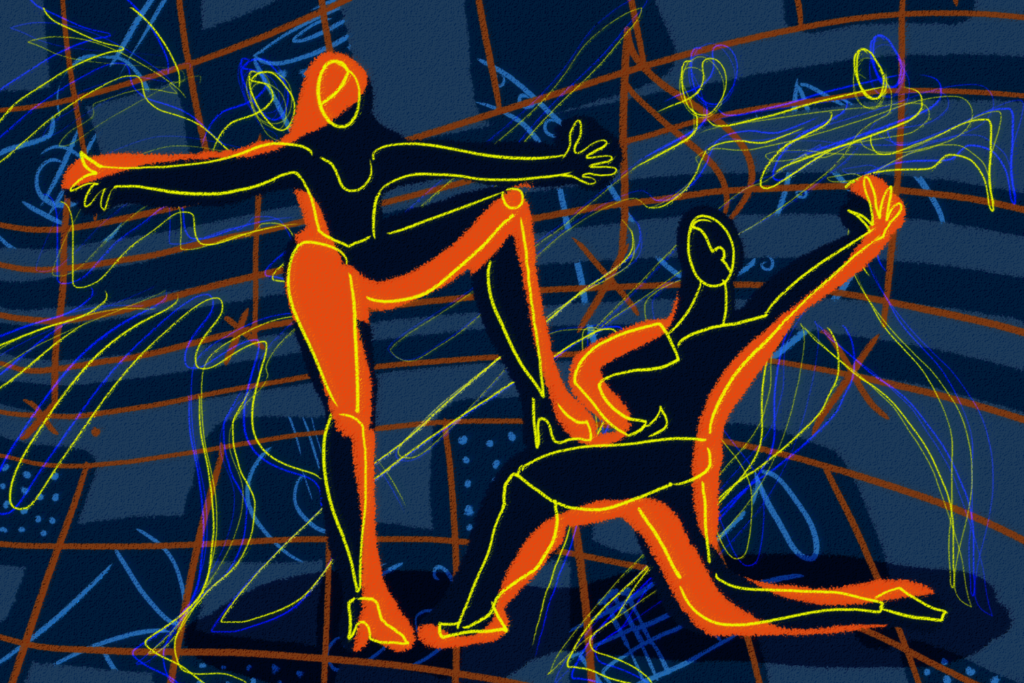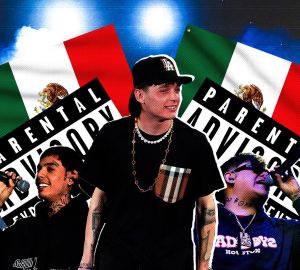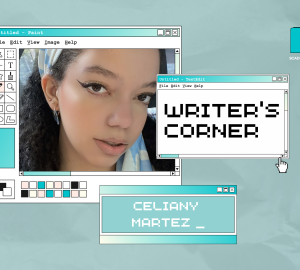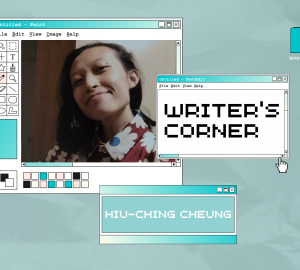
- Suena la clave
There is a method to the magic realism my people know as Salsa, a catalyst that allows an emotional escalation aimed towards a musical climax, and that is the clave: two smooth wooden cylinders used for hand percussion in a way that might seem simple to the unfamiliar onlookers, but the clash of the clave sets the starting point, introduces the rhythm, and calls the bailadores to the dance floor, their heaven.
I hated salsa growing up. Thought it was old people music and would always complain whenever my mother played it in the car, the kitchen, the living room, the entirety of our lives. She always tried to make me dance with her at the family reunions and I always frowned and declined, hearing the noise of trumpets ablaze but not listening to their poetry.
Fast-forward to ninth grade, when people realized there was more to music and parties than Reggeatón and rap, thanks to the looming approach of the quinceañeras. We knew this would be the start of consecutive large-scale parties focused on dancing and establishing a status on the nightlife, when people’s hormones were in the stratosphere and they wanted to impress and attract others. Guys reached the nerve-wracking realization that all girls already knew how to dance, while they were all as stiff as tree trunks. In the capital city of Salsa, that translated into shame. One who goes to a party to only sit down and talk becomes unremarkable, irrelevant and in some ways antisocial. Could be the football star, the most handsome guy in high school, the richest one, but if he cannot move his feet to the proper tempo, he is nothing.
My friends and I were terrified. The first big party was coming up and after a decade neglecting and loathing Salsa, we realized how crucial its acceptance was for the identity of a Caleño, so we hired a professor and started taking formal classes.
2. Suena el bongó
The bongos set an affixed tempo and their unique sound is mirrored by the movement of legs in a Salsero, who is now aware that the grand compilation of harmonious instruments approaches. The bongos are the appetizer and without them the genre wouldn’t have any sabor, flavor, because that is how Caleños describe the spark within the music and the dancer. We owe this to the Africans taken to Cuba and Cartagena in shackles by the Spaniards, and through their adversity, they maintained their culture, their drums and their dances, their sabor. We wouldn’t have Salsa without their influence.
I confess that up to this day, I defend myself with the same humble repertoire of steps that I learned back in ninth grade, basic in technical nature, but they have gotten me this far and I turned myself into a decent dancer. My friends and I learned with the same professor, and onlookers would be able to tell that if they ever saw us dancing at the same time, doing the exact same moves as if we had practiced a choreography. The difference comes in the execution of said steps, the way in which the dancers manifest their love towards the genre. Memorizing the movements isn’t enough. Your hips need to sway with sabor, your arms must be held firm and upright to show elegance and respect towards the music, you must flow with grace and confidence, and your facial expressions should be as jubilant as the music itself. One can tell when a person loves Salsa or not based on the way in which their body moves, or how their eyes shine when they’re dancing. Some settle for memorizing steps and executing them mechanically, while others take the time to read each sound, delivering everything they are and have into the melody and their partner.
When I first started learning, I was stiff, an automaton who didn’t yet appreciate Salsa the way I do now, but I enjoyed the process and sought to improve. I wanted more. I wanted to have sabor.
3. Suena el Güiro
One of my favorite instruments in Salsa is the güiro, a hollow wooden cocoon played by scraping a stick along its textured surface, its sound unique and crucial to add more spice to the melody and set the speed of the dancers. It is a romantic auditive caress that requires technique to produce, and in these past months, I have learned how to play it.
First created by indigenous tribes in South America, the guiro, like Salsa, found its home elsewhere and far from its origin.
Many will argue that Salsa originated in the Dominican Republic, Puerto Rico or Africa, and although all the aforementioned places have had substantial influence in the development and growth of Salsa, its true place of origin was New York. The pioneers were Puerto Rican, as in the late ’20s there was a massive wave of immigration from the Caribbean island to the point where Puerto Ricans became embedded in the culture of New York City. Salsa started as a bunch of young musicians mixing different rhythms from different cultures until they developed the unique sound of Salsa, among them Richie Ray, Bobby Cruz, Hector Lavoe, Willie Colón and other legendary artists. Salsa captivated a city in which the official language was English and still found ways to spread through the rest of the Americas and become a prime characteristic of Latino culture, but its true home was a small city in the south of Colombia.
Cali, known as the capital city of Salsa in the entire world.
Salseros with sharp ears can always distinguish the sound of the güiro among the beautiful chaos of a Salsa song, just like one will always distinguish a Caleño among the other clustered cultures because this vibrant genre is embedded into our identity. Foreigners see Cali as the place of sacred pilgrimage to learn Salsa, not New York or Puerto Rico, because of the way in which its people have made Salsa a part of their behavior. Caleños have sabor, they have rhythm in their accent, in the mundane movement of their limbs, in their personalities. Every year, Cali hosts a grand festival from Christmas day until New Year’s Eve, characterized by a parade of Salseros across the city, countless orchestras playing in stadiums, parks, streets — often for free — as a homage to the people and how well they have received Salsa in their home.
It is also curious to see how Colombia as a country isn’t the home of Salsa. Not even Cartagena where the slaves first landed and brought their culture with them, not the capital where everything is grey and people have static souls. Only in Cali is the genre so venerated and appreciated, so necessary for our way of life.
This is why every time I hear a clave, the bongos and a güiro together, I transport myself back home and feel surrounded by my people. It is, as I described earlier, an experience of magic realism.
Yet there is a more specific home for Salsa within its capital city, and that is a club called La Topa Tolondora, located in the west, directly upon Fifth Street. Nothing extraordinary on the outside except for the queue which, on most weekends, can go on for more than a block. The cover is the equivalent of two dollars, it is open Monday through Sunday up to four in the morning, and every day has a particular theme. It is always packed.
I discovered this place because of my best friend Valentina, the greatest salseraI know and one of the most splendid dancers I’ve seen. She calls it The Temple and goes there more often than she goes to church. Becoming one of the regulars at La Topa, she made friends with some of the most prominent dancers in the city and got me acquainted with them. When you walk inside La Topa, after a lady gives you a free shot of rum, you notice dozens of people dancing their hearts out in the most narrow of spaces, all of them smiling. Others just sit back to watch the bailadores because they are as spectacular as the dancers JLO took to the Super Bowl. They are regular people who love Salsa and see La Topa as their second home. You see them come in all kinds of clothes, because that is irrelevant in a place where your status is defined only by how well you can dance.
Upon my first visit, I realized that I was a basic dancer, nowhere near the level of the regulars, who can spin three times in the second it takes me to blink, whose feet move so fast that you wonder how they haven’t fallen off. And yet they are not arrogant, and welcome amateurs into their home to teach and show them new steps, viewing Salsa as a force of unity and sharing. In most clubs you will see people flirting and trying to score with whomever they dance with, but not in La Topa, where you dance for the sake of dancing and the love of Salsa. It is normal for strangers to ask each other out to dance, and they always accept regardless of age or class or appearance. On one occasion I noticed a beautiful woman near the bar, clearly foreign because of her white-blonde hair and outstanding height, and I wanted to dance with her and show her my sabor. The fact that she seemed over thirty made her more attractive in my eyes, too. I wasn’t expecting her to be so graceful and fluent, unlike most of the foreigners who frequent La Topa in their learning stages and lack rhythm. She said she had learned in Holland and had always wanted to visit Cali, we talked and danced throughout the song and parted ways as friends. I was happy.
Seconds later my jaw dropped to the punished floor as I saw her dancing with one of the regulars, and it turned out that this woman from Holland, danced just as well as the finest dancers in La Topa. Better than my friend Valentina even. I was stunned, a bit ashamed about my humble moves in comparison, but beyond that, I was happy to realize just how far Salsa had traveled. How it breached frontiers and moved other cultures, spreading the Caleño spirit to others who don’t even speak Spanish.
You never know what crazy thing you’ll find at La Topa. It never gets boring, unlike the American parties where all they do is scream and jump up and down with no rhythm whatsoever.
My friends and I are always the youngest in La Topa, so on the many occasions when we encounter school teachers and parents there, they act surprised for a second and then just hang out with us. I’ve taken shots of aguardiente with my old P.E. teacher, one of the school janitors, the chemistry teacher and people I’ve never met because La Topa has that magic effect of erasing labels and names.
We’re all salseros there, we’re all friends.
4. Trompeta, Piano y Pregones
The true spectacle of salsa comes from the unison of trumpets and the piano above the instruments mentioned before. This is when a song explodes, when the bailadores transcend into their happiest selves and leave marks on the tiles beneath their feet. Early into my introduction to Salsa, I discovered that my favorite kind of song was the wild, chaotic and extreme, where the pianist finger’s bleed and the other musicians play as if possessed by an external force. Add to that a strong pregón — a verse delivered by the singer with passion and sincere sentiment — and I will lose myself in the music and forget that there exists an entire world outside the song.
Despite the sounds, the spectacle of Salsa is its therapeutic power. Forget counseling, meditation and prescribed medication. I am a firm believer that there is no sorrow or misfortune that cannot be eased by guaguancó, no scowl that can resist bending into a smile as the güiro whispers in the background. Salsa detaches the listeners from their lives and immerses them into the song and the dance where their bodies perform an act that celebrates joy and art, where the smile comes to a person’s face uninvited, and yet it lingers. I’ve had days that can only be described as shitty, raids of anxiety and panic, but if I play La Comay or Sonido Bestial, I find myself mentally incapable of feeling sad. It is instant therapy. Even if the lyrics in a pregón happen to depict a tragedy as in Pedro Navaja, I will find myself elevated and consumed by joy. That is the reason why I want no prayers at my funeral. I want instruments, the sounds of home, bailadores instead of priests and mourners.
I want people to remember what made me feel the most alive, but for now, I’ll keep on dancing, knowing that for as long as there is a Caleño still in the world, Salsa will never die.























